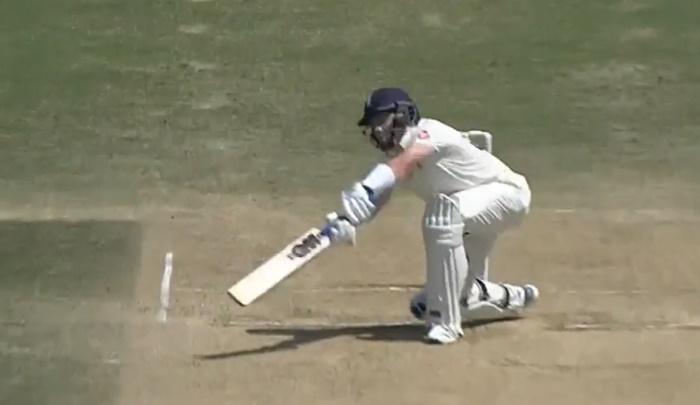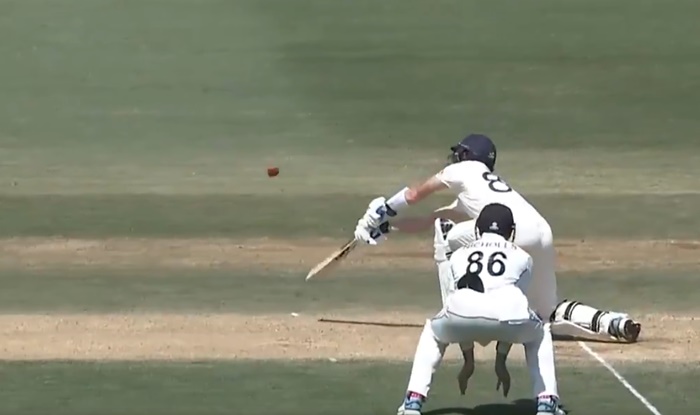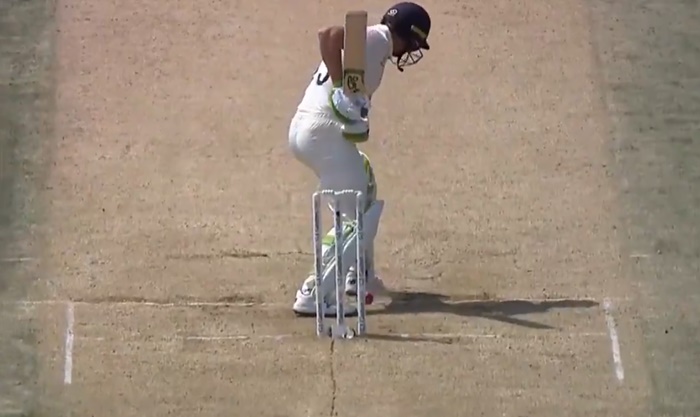
Two dismissals, two wickets for The Great Neil Wagner – but which one was the stupidest?
England committed greater crimes during the first Test, but none were funnier than the dismissals of Ollie Pope and Jos Buttler in their second innings.
One innings after stretching for a wide one and getting caught, Ollie Pope stretched even further for an even wider one and got caught.

It was very fine.
Not to be outdone, Jos Buttler left a yorker that hit his stumps.

It was also very fine.
We were going to do some analysis to try and work out which dismissal was the worse, but we’ve decided against it. They work too well as a pair.
Pope’s has the benefit of being an exaggerated version of what he did wrong in the first innings. Buttler’s scores extra points for coming straight after Pope’s at a time when England really didn’t need their last proper batsman to watch a ball hit his stumps.
Excessive proactivity and excessive passivity. Too great a desire to lay bat on ball and too great a willingness to refrain from doing so.
Pope and Buttler.



The stretch is the one that would annoy me more, I think.
That’s mainly because a batsman leaving a ball (or, ideally playing an ostentatious ‘textbook forward defensive’ in the wrong place) and the ball hitting the stumps is, frankly, hilarious, which would temper my annoyance.
The ‘go go Gadget Arms’ wide drive was pretty damn funny too.
In test match cricket, especially when dealing with a tricky period such as early in the match/innings or batting out a draw, chasing a wide one is the greater sin.
In short form cricket, leaving a straight one is the greater sin.
Both are failures of technique (or in the modern parlance, “execution”)m but in addition a key element of batting requires deploying your cricket brain to the situation.
The “greater sins” as I have described them above are a failure of contextual thought as well as a failure of technique.
I have sinned on my time, oh Lord forgive me, I have sinned.
Take your point about a failure of contextual thought, but there’s a simpler way of looking at it that is surely no less valid.
If a ball is aimed at your stumps and you leave it, there is a near 100 per cent chance you will be dismissed. (No balls and freak bail bounces are about the only things that could save you.)
Chasing a wide one, there is still a decent chance you’ll survive.
Can a shot ever be worse than leaving a straight one?
Bert addresses this below so I won’t bother writing everything I was going to, but the straight one is not – in the batsman’s mind at least – going to hit. It is like all the other straightish ones, 80% going to just miss, 15% not as straightish as it has been perceived and going to miss by quite a way, 5% more straight than it has been perceived and actually going to whack the stumps. Adjust percentages to taste, but the ball-as-it-so-manifests is just one ball on the spectrum of balls-compatible-with-the-ball-as-it-is-perceived. Though sadly/hilariously it’s the one that actually matters…
That isn’t what Hawk Harrelson meant by stretch, Ollie.
https://www.youtube.com/watch?v=czCXZADERpU
Leaving a straight delivery is an error of judgement. It’s clear that the batsman expects the ball to miss the stumps, so in that sense that is what he is trying to achieve by his decision. If the ball misses, he is vindicated.
Chasing a wide one is more interesting. These batsmen are trained to the peak of their abilities. They understand implicitly that control is everything, and conversely that a lack of control is risky. So what is the batsman trying to achieve by going after a ball he can barely reach? Not a boundary, surely, unless he is particularly stupid.
So it seems to me that chasing a wide one comes about because at first the batsman thought it would come closer to him, and then when it turns out that is not the case, he literally cannot stop his arms from continuing with his brain’s initial instruction. I have this playing rugby, when you can see that the pass is going to be intercepted but cannot prevent yourself from continuing through with it. It is a car crash moment, played out in crystal clear slow motion in your head.
So the wide chase is the funnier, because of the horror it will inevitably inspire in the batsman while he is doing it. But having said that, leaving a straight one is much, much funnier in the aftermath – bat held sensibly out of the way, stumps demolished, realisation slowly dawning. In short, each has its own particular delight.
Does this also apply to high tackles?
In cricket?
Exactly. The realisation dawning (or perhaps the moment just before the realisation dawns) is the highlight, much in the manner of Wile E. Coyote having just run off the side of a sheer cliff, then looking down.
I’m only here to express my satisfaction. And use my honorific. And insist that you always call Neil Wagner The Great Neil Wagner. And let you know that after Day 1 I was sure England would win.
Think we pretty much do always refer to him as that. We know that some here go in for a TGNW, but we’re not that big on initialisms.
If anyone else wants a comments section honorific, they’re literally for sale.
https://www.patreon.com/kingcricket
M’lady.
Leaving the straight one pretty much always makes the batsman feel worse than the ludicrously chased one.
For the latter, the batsman can claim, with some veracity, that it was a poor ball and that instinct to punish the bad ball took over. Whereas leaving a straight one is manifestly poor judgment by the batsman and his fault alone.
Still stand by my context point, though, when looking at the question as objectively as I can.
Bit cis, the KC honorifics, aren’t they, your majesty? Whereas “your majesty” is a non-binary honorific. Might I politely suggest that you get woke, my liege?
It’s a good point. What do you suggest?
Honourable, Right Honourable, Most Honourable…
But then again, as Jayne would no doubt sing from the rafters, “there is nothing like a dame”…
Rahkeem Cornwall takes a seven-fer.
Normally I’d be gutted that Afghanistan folded so fast, but it’s Cornwall so I’m delighted instead.
Sorry, forgot my title.